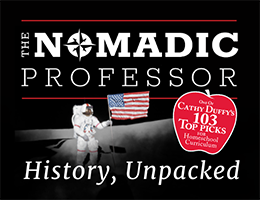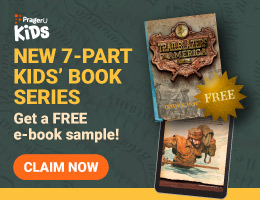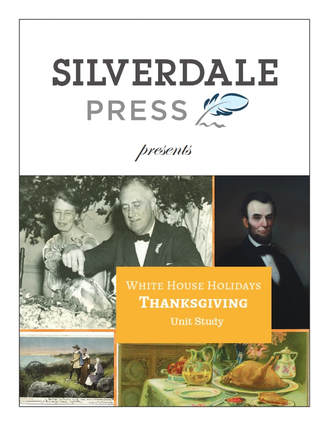Silverdale Press publishes a number of short-duration unit studies on holidays, adding an unusual twist by studying them through the lives of American presidents and their families. These studies can be used with students in kindergarten through twelfth grade. The studies Thanksgiving, Veteran’s Day, Labor Day, Martin Luther King, Jr. Day, and Valentine’s Day rely more on reading than on projects or activities, even for younger students. Another study on Christmas differs from the others with lots of craft and cooking activities rather than lots of reading.
Study guides range from 53 to 78 pages. A separate, brief answer key comes with each one. These guides and keys are available only as downloadable PDF files. While you are free to print out the PDF files (for the whole family), there are useful web links within the PDF file which you will want to easily access.
Primary source documents play a significant role in these studies, a unique feature that differentiates these studies from others. The use of primary source documents for reading, discussion, and research also fits well with requirements in the Common Core State Standards for language arts.
Most studies have separate sets of activities for two levels: one level for kindergarten through sixth grade and the other for grades six through twelve. Activities are on similar topics, but for older students there are lengthier sections to read and more-challenging activities. Older students will complete more written activities while younger students will do little or no writing, so parents should adapt activities so that they adequately challenge students. For instance, asking a sixth grader to write answers to questions while discussing them with a first grader.
Discussion questions, particularly those related to primary source documents, provide a great opportunity to apply critical thinking skills. You might discuss questions with younger children and have older students write some of their answers. For example, the Labor Day study’s questions for older students include some comprehension questions like this one pertaining to President Franklin Roosevelt’s Fireside Chat on September 6, 1936: “What rights and protections did FDR say that workingmen should have?” But, it also asks, “Do you agree or disagree with FDR’s philosophy of government? Explain” (page 46). The latter question provides an opportunity for a lively discussion, while the first does not.
Studies include information to read to students, some of which is from primary source documents (e.g., presidential letters or speeches) that are included within the studies. You won’t have to search for source documents. Occasionally, questions follow primary source readings. From time to time, research assignments ask students to search online for answers to specific questions. Sometimes there are links to online videos, audio files, and sources of information. These links are optional in some studies, but sometimes they are essential. For example, in the third lesson of the Labor Day study, younger students need to search two online historical databases for images they will use to illustrate a visual, historical narrative about George Pullman and the labor movement.
There are some hands-on projects such as the visual narrative I just described, creation of a poster, drawing, and occasional cooking or baking projects. The Christmas study adds many other projects such as creating a nativity scene, a Christmas card, and a cranberry tree. These projects usually require only resources you are likely to have around the house or can easily get.
Studies vary in the time needed for completion. Veteran’s Day and Labor Day studies are the shortest with three lessons that might take as few as three days to complete, while others take up to five weeks to complete. You might spend a few hours on an entire lesson, or the same amount of time on just one activity. For example, the five Thanksgiving lessons take from one to two hours each to complete. In contrast, the Christmas study is designed so that there are 24 activities that would ideally be completed one per day leading up to Christmas.
Connections made between holidays and presidents and their families are sometimes very natural, as in the Labor Day Study which includes topics such as Eleanor Roosevelt work to abolish child labor and President Grover Cleveland's actions during the Pullman strike. The Valentine’s Day study makes connections with the love letters of John and Abigail Adams, letters of Ronald and Nancy Reagan, White House weddings of two presidents, and Jacqueline Kennedy’s 1962 Valentine’s Day tour of the White House. The Thanksgiving study makes the connection with the topic of presidential proclamations of Days of Thanksgiving. Christmas changes things up by focusing on First Ladies, crafts, decorations, and cooking.
Students learn a significant amount of history in these studies, so they can fit well within studies of U.S. history. The Thanksgiving study fits in with the early colonial period, but might be used at any time since it teaches about the development of the holiday as well as its origins. The Labor Day study fits with the era of the Industrial Revolution and its aftermath. Veterans Day focuses primarily on Woodrow Wilson (the era of WWI), but the third lesson (of three total) is on Dwight Eisenhower (WWII). The Martin Luther King, Jr. study addresses the modern civil rights movement. Valentine’s Day and Christmas studies teach some history, but the history is more incidental to the topics than in other studies. As you can see, most of these studies might work well as a part of U.S. history coursework, but they also serve as a way to teach children the origins and meanings of these holidays.
In summary, each Silverdale Press White House Holidays unit study offers families opportunities to learn about holidays while advancing both academic learning goals and family fun. Some sample lessons are available free on the website, so you can check it out yourself before buying.











